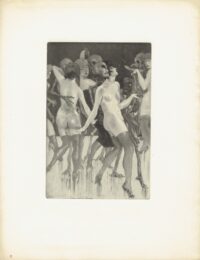

Édouard Chimot (1880–1959) was a French artist, illustrator, and publisher whose creative journey left an indelible mark on the world of visual arts. Born on November 26, 1880, in Lille, France, Chimot’s early fascination with art led him to pursue formal training at the École des Beaux-Arts in Paris. His exceptional talents soon garnered attention, and he began illustrating books and magazines.
Chimot’s artistic style was characterized by its sensual and romantic nature. He had a keen ability to capture the delicate nuances of the human form, often portraying subjects in graceful, flowing lines that exuded elegance. His affinity for depicting the female figure with a sense of mystique and allure became a hallmark of his work.
His collaborations with notable writers and poets, including Paul Verlaine and Charles Baudelaire, brought his illustrations to the forefront of the Art Nouveau movement. Chimot’s work not only complemented the literary content but also added an extra layer of emotional depth to the texts. He used various techniques, such as etching and aquatint, to create intricate, evocative images that resonated with audiences.
Beyond his role as an artist, Chimot’s influence extended to the realm of publishing. In 1920, he founded his own publishing house, the Éditions d’Art Édouard Chimot. Through this venture, he not only continued to create his own art but also collaborated with other artists and writers to produce limited-edition books, often featuring his distinctive illustrations.
Throughout his career, Chimot’s work evolved, adapting to the changing artistic currents of the time while maintaining his unique sensibilities. He bridged the gap between traditional art and modern aesthetics, earning recognition and acclaim for his contributions to the decorative arts and book illustration.